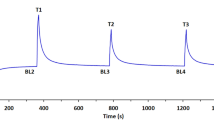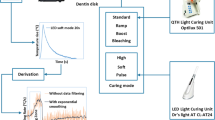Abstract
This study assessed the Knoop hardness and temperature increase provided by three light curing units when using (1) the manufacturers’ recommended times of photo-activation and (2) standardizing total energy density. One halogen – XL2500 (3M/ESPE) – and two light-emitting diode (LED) curing units – Freelight (3M/ESPE) and Ultrablue IS (DMC) – were used. A type-K thermocouple registered the temperature change produced by the composite photo-activation in a mold. Twenty-four hours after the photo-activation procedures, the composite specimens were submitted to a hardness test. Both temperature increase and hardness data were submitted to ANOVA and Tukey’s test (5% significance). Using the first set of photo-activation conditions, the halogen unit produced a statistically higher temperature increase than did both LED units, and the Freelight LED resulted in a lower hardness than did the other curing units. When applying the second set of photo-activation conditions, the two LED units produced statistically greater temperature increase than did the halogen unit, whereas there were no statistical differences in hardness among the curing units.



Similar content being viewed by others
References
Asmussen E (1982) Factors affecting the quantity of remaining double bonds in restorative resin polymers. Scand J Dent Res 90:490–496
Asmussen E, Peutzfeldt A (2003) Influence of specimen diameter on the relationship between subsurface depth and hardness of a light-cured resin composite. Eur J Oral Sci 111:543–546
Baldissarra P, Catapano S, Scotti R (1997) Clinical and histological evaluation of thermal injury thresholds in human teeth: a preliminary study. J Oral Rehab 24:801–971
Caughman WF, Rueggeberg FA (2002) Shedding new light on composite polymerization. Oper Dent 27:636–638
Čejková J, Típek S, Crkovská J, Ardan T, Láteník J, Èejka È, Midelfart A (2004) UV rays, the prooxidant/antioxidant imbalance in the cornea and oxidative eye damage. Physiol Res 53:1–10
DeWald JP, Ferracane JL (1987) A comparison of four modes of evaluating depth of cure of light-activated composites. J Dent Res 66:727–730
Ferracane JL (1995) Current trends in dental composites. Crit Rev Oral Biol Med 6:302–318
Goodis HE, White JM, Andrews J, Watanabe LG (1989) Measurements of temperature generated by visible-light-cure lamps in an in vitro model. Dent Mater 5:230–234
Halvorson RH, Erickson RL, Davidson CL (2002) Energy dependent polymerization of resin-based composite. Dent Mater 18:463–469
Hannig M, Bott B (1999) In-vitro pulp chamber temperature rise during composite resin polymerization with various light-curing LCUs. Dent Mater 15:275–281
International Organization for Standardization Specification, ISO TS 10650 (1999) Dental equipment-powered polymerization activators. Geneva, Switzerland
Knezevic A, Tarle Z, Meniga A, Sutalo J, Pichler G, Ristic M (2001) Degree of conversion and temperature rise during polymerization of composite resin samples with blue diodes. J Oral Rehabil 28:586–591
Kurachi C, Tuboy AM, Magalhães DV, Bagnato VS (2001) Hardness evaluation of a dental composite polymerized with experimental LED-based devices. Dent Mater 17:309–315
Loney RW, Price RB (2001) Temperature transmission of high-output light-curing units through dentin. Oper Dent 26:516–520
Lovell LG, Newman SM, Donaldson MM, Bowman CN (2003) The effect of light intensity on double bond conversion and flexural strength of a model, unfilled dental resin. Dent Mater 19:458–465
Nomoto R (1997) Effect of light wavelength on polymerization of light-cured resins. Dent Mater J 16:60–73
Peutzfeldt A, Sahafi A, Asmussen E (2000) Characterization of resin composites polymerized with plasma arc curing units. Dent Mater 16:330–336
Price RB, Felix CA, Andreou P (2005) Knoop hardness of ten resin composites irradiated with high-power LED and quartz-tungsten-halogen lights. Biomaterials 26:2631–2641
Rueggeberg FA, Craig RG (1988) Correlation of parameters used to estimate monomer conversion in a light-cured composite. J Dent Res 67:932–937
Rueggeberg F (1999) Contemporary issues in photocuring. Compend Contin Educ Dent 20:S4–S15
Schneider LF, Cavalcante LM, Tango RN, Consani S, Sinhoreti MA, Correr-Sobrinho L (2005) Pulp chamber temperature changes during resin composite photoactivation. Braz J Oral Sci 4:685–688
Schneider LF, Consani S, Sinhoreti M, Correr Sobrinho L, Milan F (2005) Temperature change and hardness with different resin composites and photo-activation methods. Oper Dent 30:516–521
Shortall AC, Harrington E (1998) Temperature rise during polymerization of light-activated resin composites. J Oral Rehab 25:908–913
Stansbury JW (2000) Curing dental resins and composites by photopolymerization. J Esthet Dent 12:300–308
Stewardson DA, Shortall ACC, Harrington E, Lumley PJ (2004) Thermal changes and cure depths associated with a high intensity light activation unit. J Dent 32:643–651
Uhl A, Mills RW, Jandt KD (2003) Polymerization and light-induced heat of dental composite cured with LED and halogen technology. Biomaterials 24:1809–1820
Vandewalle KS, Ferracane JL, Hilton TJ, Erickson RL, Sakaguchi RL (2004) Effect of energy density on properties and marginal integrity of posterior resin composite restorations. Dent Mater 20:96–106
Yap AU, Seneviratne C (2001) Influence of light energy density on effectiveness of composite cure. Oper Dent 26:460–466
Zach L, Cohen G (1965) Pulp response to externally applied heat. Oral Surg Oral Med Oral Pathol 16:515–530
Acknowledgement
The authors thank the Institute of Physics at the São Paulo University (USP, São Carlos Campus), especially to Prof. Dr. Cléber Renato Mendonça, for the spectrometer collaboration.
Author information
Authors and Affiliations
Corresponding author
Rights and permissions
About this article
Cite this article
Schneider, L.F., Consani, S., Correr-Sobrinho, L. et al. Halogen and LED light curing of composite: temperature increase and Knoop hardness. Clin Oral Invest 10, 66–71 (2006). https://doi.org/10.1007/s00784-005-0028-x
Received:
Accepted:
Published:
Issue Date:
DOI: https://doi.org/10.1007/s00784-005-0028-x




